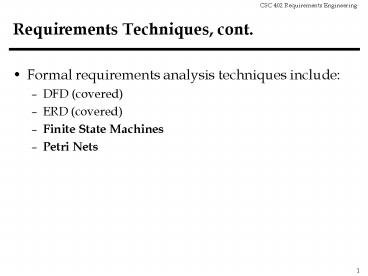Requirements Techniques, cont. - PowerPoint PPT Presentation
Title:
Requirements Techniques, cont.
Description:
Requirements Techniques, cont. Formal requirements analysis techniques include: DFD (covered) ERD (covered) Finite State Machines Petri Nets – PowerPoint PPT presentation
Number of Views:97
Avg rating:3.0/5.0
Title: Requirements Techniques, cont.
1
Requirements Techniques, cont.
- Formal requirements analysis techniques include
- DFD (covered)
- ERD (covered)
- Finite State Machines
- Petri Nets
2
Finite State Machines
- A requirements technique for modeling the states
and transitions of a software system - Finite state machines are used in other contexts
- automata theory and compilers, for example
- More precise than data-flow diagrams
- data-flow diagrams specify only the nature of a
systems data flow (e.g. the what and the where) - finite state machines provide information on how
a system progresses from state to state - what is state
3
Formal Definition
- The definition of a finite state machine (FSM)
consists of five parts - a set of states
- a set of inputs
- a transition function
- the initial state
- a set of final states
4
Simple Example
- States of a combination lock for a safe
- Safe has a dial with three positions (1, 2, 3)
- The dial can be turned in two possible directions
- At any point six possible motions
- Turn left to 1 (1L)
- Turn right to 1 (1R)
- etc...
- Combination is 1L, 3R, 2L
- The possible states include the safe being locked
and unlocked, sounding the alarm, and the steps
along the combination (e.g. 1L and 3R)
5
Example, cont.
- Set of States (Locked, A, B, Unlocked, Alarm)
- Set of Inputs (1L, 1R, 2L, 2R, 3L, 3R)
- Transition Function (next two slides)
- Initial State (Locked)
- Final States (Unlocked, Alarm)
6
Example, cont.
locked
a
b
unlocked
1L
3R
2L
X
X
X
alarm
any other input
X
initial state
final state
7
Transition Table
Input
1L
1R
2L
2R
3L
3R
8
Finite State Machine Wrap-Up
- More advanced examples in other textbooks
- The infamous Elevator Example is a good one
(Schach) - Demonstrates
- The specification power of FSMs
- Typical Problem
- The number of states and transitions grows
rapidly in large systems - Approach decompose problem into smaller
subsystems - Tool support exists for this and related
techniques (e.g. statecharts)
9
Petri Nets
- A formal technique suited for specifying the
properties of concurrent or multithreaded systems - Typical concurrency problems
- race conditions
- X accesses Y before Z updates it
- deadlock
- X is waiting on Y which is waiting on X
- Petri nets can be used to help avoid ambiguity in
specifications that can lead to this class of
problems in multithreaded systems
10
Formal Definition of Petri Nets
- A Petri net consists of four parts
- A set of places
- A set of transitions
- An input function
- An output function
- In the subsequent diagrams, the input and output
functions are represented by arrows
11
Petri Net Parts
Place
Transition
Token
12
Firing a transition
A transition fires when it has a token at each
input place as a result a token is placed at
each output place.
13
Simple Example
- A server cannot send an event to a client until
the client has indicated that it is ready to
receive one - Approach
- Map states into places
- Map events into transitions
- States
- Event waiting
- Event received
- Event processed
- Client Ready
- Events
- Generate Event
- Send Event
- Process Event
- Notify server
14
Example, cont.
Event Generator
Event Waiting
Event Received
Event Processed
Generate Event
Process Event
Send Event
Client Ready
Notify Server
Three events one being received
15
Example, cont.
Event Generator
Event Waiting
Event Received
Event Processed
Generate Event
Process Event
Send Event
Client Ready
Notify Server
An event gets generated
16
Example, cont.
Event Generator
Event Waiting
Event Received
Event Processed
Generate Event
Process Event
Send Event
Client Ready
Notify Server
An event gets processed waiting event must wait
since Send Event cannot fire.
17
Example, cont.
Event Generator
Event Waiting
Event Received
Event Processed
Generate Event
Process Event
Send Event
Client Ready
Notify Server
Another event gets generated
18
Example, cont.
Event Generator
Event Waiting
Event Received
Event Processed
Generate Event
Process Event
Send Event
Client Ready
Notify Server
The client notifies the server
19
Example, cont.
Event Generator
Event Waiting
Event Received
Event Processed
Generate Event
Process Event
Send Event
Client Ready
Notify Server
An event is sent...
20
Example, cont.
Event Generator
Event Waiting
Event Received
Event Processed
Generate Event
Process Event
Send Event
Client Ready
Notify Server
Second event is processed...
21
Example, cont.
Event Generator
Event Waiting
Event Received
Event Processed
Generate Event
Process Event
Send Event
Client Ready
Notify Server
The client notifies the server
22
Example, cont.
Event Generator
Event Waiting
Event Received
Event Processed
Generate Event
Process Event
Send Event
Client Ready
Notify Server
Final event is sent...andeventually processed
(ghost token)
23
Final State
Event Generator
Event Waiting
Event Received
Event Processed
Generate Event
Process Event
Send Event
Client Ready
Notify Server
Client is ready for next event
24
Petri Net Wrap-Up
- Clean notation for specifying concurrent
properties - Graphical notation hides underlying formalism
- Makes it easier to understand
- Tool support and execution engines exists for
this technique - The latter can help in testing how well a Petri
netspecifies a property by running it on test
cases































